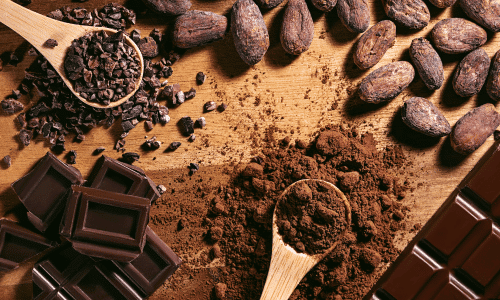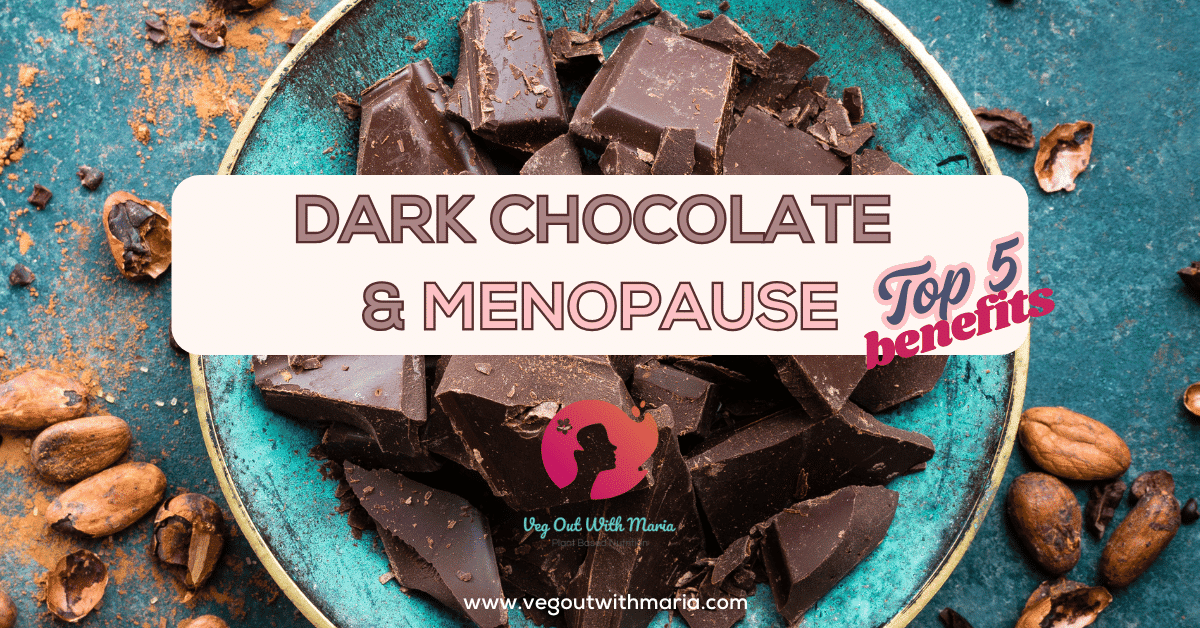Menopause brings a wave of hormonal shifts that can impact everything from mood and brain function to heart health and metabolism. Instead of being overly restrictive with your diet, what if a simple indulgence could help?
Dark chocolate is nutrient-dense and rich in phytoestrogens, polyphenols, and antioxidants, offering potential benefits that can support women during menopause. In this blog, we’ll explore the top five ways dark chocolate can be a fun and effective ally for menopausal health.
1. Nutrient Dense: A Superfood For Menopause?
Unlike milk chocolate, which contains more sugar and dairy, dark chocolate has a higher cocoa content, making it a concentrated source of antioxidants, polyphenols, flavonoids, and essential minerals, contributing to your overall health.
Minerals
Dark chocolate is rich in magnesium, potassium, and phosphorus, with a little plant-based iron and zinc.
- Magnesium plays an important role in reducing stress, improving sleep, and supporting bone health. For more on this crucial mineral, I recommend reading Magnesium For Perimenopause.
- Potassium is particularly beneficial for managing blood pressure, improving vascular function, and may even contribute to bone health by helping regulate calcium levels, especially as estrogen levels decline, which can increase cardiovascular risks for women in this stage of life.1
Healthy Fat
The primary fat found in dark chocolate comes from cocoa butter which contains a mix of oleic acid (a monounsaturated fat like olive oil), considered heart-healthy, and two forms of saturated fat: stearic acid, which has a neutral effect on cholesterol and a small amount of palmitic acid (a saturated fat known to raise cholesterol).2
Fiber
Yes, dark chocolate contains fiber! A 1 oz serving of dark chocolate usually contains 3-4g of fiber. I can’t think of a more fun way to support your gut health. The fiber and fat content in dark chocolate can also help promote satiety.
Caffeine
It’s important to note that dark chocolate also contains a small amount of caffeine (around 11-23 mg per 1 oz), along with another natural stimulant called theobromine (an alkaloid from the cacao bean).
This can offer a mild, steady energy boost without the jitters commonly associated with coffee (although, if you are a coffee lover, check out the post Benefits Of Coffee On A Plant-Based Diet). This can make dark chocolate a great snack to bring with you on a hike or before a workout.
2. Phytoestrogens: Natural Hormonal Support
Does dark chocolate increase estrogen? Not directly, but it does contain phytoestrogens, natural plant compounds that can mimic estrogen in the body by binding to certain estrogen receptors.
While they have a weaker effect than the body’s own estrogen, they can still help balance hormone levels, especially during menopause when estrogen declines.
Benefits of Phytoestrogens for Menopause:
- May support cognitive function and mood stability.
- May help reduce hot flashes and night sweats.
- Support bone health by reducing bone loss.
- Promote heart health by improving cholesterol levels.
I discuss phytoestrogens and include links to studies associated with the potential benefits in the blog: Menopause & A Plant-Based Diet.
Dark chocolate contains multiple types of phytoestrogens (including catechins and resveratrol), which, along with its other nutrients, may help support hormonal balance during menopause.
3. Gut Health, Mood & Cognitive Function
Prebiotic
Dark chocolate can improve gut health by acting as a prebiotic, nourishing beneficial gut bacteria like Lactobacillus and Bifidobacterium.3,4
In addition to fiber, its rich polyphenol content supports microbial diversity, helping to reduce inflammation and strengthen the gut barrier.
Mood

You wouldn’t think gut health would affect your mood and brain function, but your gut communicates with your brain more than we ever realized. Surprisingly, roughly 90-95% of the “feel-good” neurotransmitter serotonin is produced in the gut, not the brain.5
One triple-blind, randomized clinical trial took 60 menopausal women and randomized them to receive either 78% dark chocolate (12 g/day) or milk chocolate (12 g/day) for eight weeks. The mean depression scores for those receiving dark chocolate were significantly reduced.6
Cognitive Function
Another 4-week study of 104 participants found that those consuming 72% dark chocolate (635 mg of cocoa polyphenol) daily had reduced mental and physical fatigue and enhanced vitality, memory, and gray matter volume. This improved both physical as well as emotional function, relief of bodily pain, and social functioning.6
4. Polyphenols and Antioxidants: Reducing Oxidative Stress & Inflammation
Estrogen decline increases oxidative stress, accelerating aging and increasing your risk for chronic disease. Dark chocolate is packed with polyphenols and antioxidants, which help fight free radicals and may improve systemic oxidative stress and inflammation.7
This can potentially benefit joint pain, skin health, and overall cellular protection.
5. Cardiovascular Health & Metabolic Support

You have probably heard that postmenopausal women face a higher risk of heart disease due to lower estrogen levels. The polyphenols in dark chocolate support heart health by releasing nitric oxide, lowering blood pressure, improving circulation, and reducing LDL (“bad” cholesterol).7,8
Menopause can also increase the risk of insulin resistance and type 2 diabetes. Dark chocolate may enhance insulin sensitivity, helping regulate blood sugar levels.9,10
These benefits, of course, are only if you watch your portions and don’t overconsume it (the hard part!). Dark chocolate is rich in calories and often added sugar.
Cacao or Cocoa? What’s The Difference?
Is cacao powder the same as cocoa powder? Good question! They are both very similar and come from beans from the cacao plant. Once the beans are separated from the cocoa butter, they are fermented (to add flavor). This is the point at where they differ.
After fermentation, cocoa beans go on to be roasted at high temperatures, whereas cacao beans are not roasted and are processed at much lower temperatures. This results in a powder that is more bitter in taste but potentially contains higher amounts of nutrients and antioxidants.
Dark Chocolate & Heavy Metals
While dark chocolate offers many health benefits, it can sometimes be contaminated with heavy metals like lead and cadmium, which are absorbed from the soil during cocoa bean growth.
Long-term excessive exposure to these metals may pose health risks, particularly for kidney function, nervous system health, and bone strength.
To minimize exposure, choose high-quality brands that test for contaminants. One of my favorite dark chocolate brands is Chocolove. They provide information on their website addressing this concern and are SQF (safe quality food) certified.
The associated health benefits of dark chocolate are seen with a higher percentage of cocoa content – at least 70% – but it has been suggested that cadmium and lead levels tend to increase with the percentage of cocoa. So, choosing 70% over 80% might be a better choice.
How To Choose The Best Dark Chocolate
The following are tips on how to choose the best dark chocolate:
- Opt for at least 70% cocoa for higher antioxidant content. Milk chocolate contains far less beneficial cacao and is made with milk and typically higher amounts of sugar. White chocolate doesn’t even contain cacao, so there’s no real benefit there.
- Avoid alkali processed “dutched” cocoa. This is a type of processing used to lower the acidity or bitterness and make it a darker color. A lot of the polyphenol and antioxidant properties are lost during this process.
- Avoid chocolate that has too many extra ingredients. The main ingredients should be chocolate or cocoa liquor, sugar, cocoa butter, soy lecithin (used as an emulsifier), and vanilla.
- Choose high-quality brands that test for contaminants. A few brands that use third-party testing are: Taza, Mast, Alter Eco, Villakuyaya, Chocolove.
How Much Dark Chocolate Should You Have?
A commonly recommended serving size is 30g or 1 oz. This is usually 1/3 of a bar. Enjoy the benefits without the excessive calorie and sugar content.
Bottomline
Dark chocolate isn’t just a delicious indulgence—it’s a nutrient-dense superfood that can offer real benefits for women navigating menopause. Packed with essential minerals, phytoestrogens, and gut-friendly compounds, it supports hormonal balance, digestion, and overall well-being.
Its mood-boosting effects and cognitive benefits can help combat brain fog and stress, while its polyphenols and antioxidants work to reduce oxidative stress and inflammation, protecting long-term health.
Plus, dark chocolate’s ability to lower cardiovascular disease risk and potentially improve insulin sensitivity makes it a heart-healthy and metabolism-friendly choice.
By choosing high-quality dark chocolate with minimal added sugars, you can enjoy its benefits as part of a balanced, plant-based diet—proving that a little sweetness can go a long way in supporting vibrant health.



Looks like you’ve justified more chocolates in my life. Couldn’t be happier. Nice work!